 "QUANTUM SHOT" #463 "QUANTUM SHOT" #463link This article is written by RJ Evans, ed. by Avi Abrams Water on the Web - Nature's Jewelry Dew drops, each a splendid world of reflection - caught in a silvery web on an early morning: 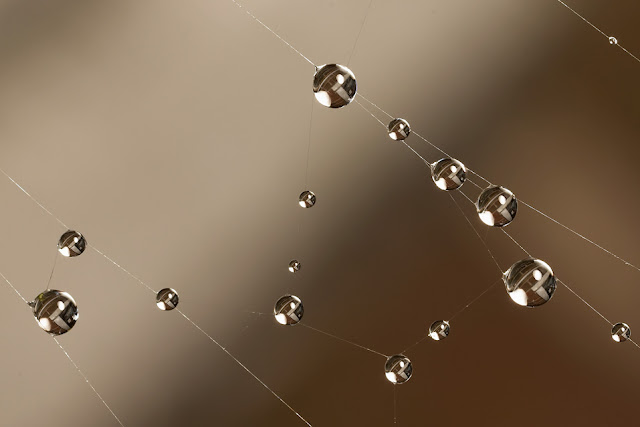 (image credit: Brian Valentine, see the whole wonderful set here)  (image credit: Evan Leeson) Another one from his "A Thousand Drops of Light" set:  (image credit: Evan Leeson)  (original unknown) Freezing fog created these icy decorations on a cobweb:  (image credit: fenlandsnapper) Nature Imitates Man? 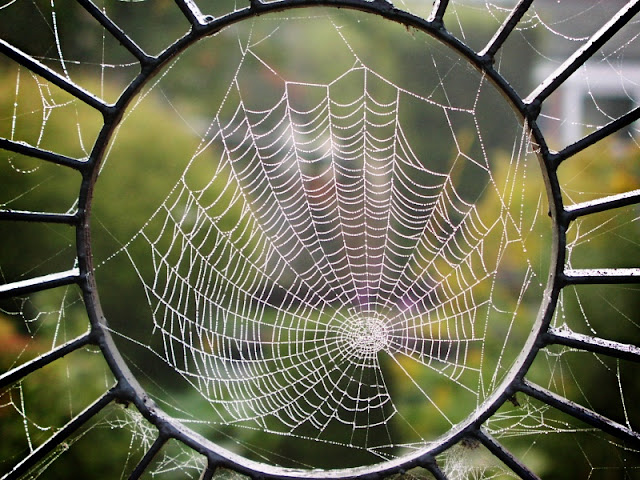 (image credit: kieran_m) Such is the strength of the design of the spider web that it has been adapted in to much of our own architecture. Sometimes the spiders seem to get their ideas from us, but that really isn’t the case! The thread that spiders produce come from glands called spinnerets. There are, so far, seven different types of spinnerets that have been identified and each one has a separate purpose. Each type of spider will possess a few of these spinneret glands, but there has never been a recorded case of a spider having all seven types! Home is where you weave it Not all spider webs are spiral or orbic in shape, though these are the most common: 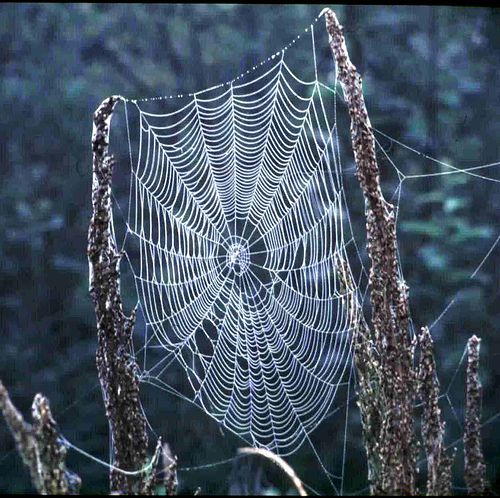 (image credit: moonjazz) Black Hole Fly Nemesis There are sheet webs, like this one - with the spooky “black” hole at the center! -  (image credit: Paul) Then, there are funnel and tubular webs – the names speak for themselves... Finally there are dome or tent webs that can cover huge areas. The capture silk above is from the “fluffy” variety. Orb webs that most people usually associate with spiders use “sticky” silk. 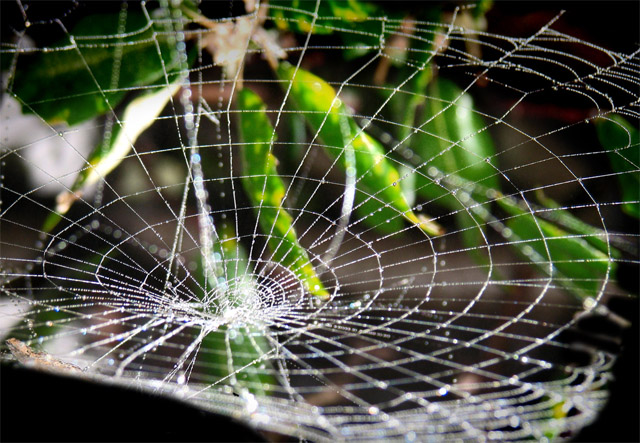 (image credit: Mike) It took Homo sapiens thousands of years of thought to come up with the idea of ergonomics, but spiders have been at it for millions of years. When making its web, the spider will use its own body for measurement. In this way the web is the ultimate in practicality and ergonomic design. The spider is able to get around the web extremely quickly and efficiently and will not fall through the holes! Dawn  (image credit: Mark) Have you ever had job to do that is so daunting it takes you an incredibly long time just to get around to starting it, if you ever start it at all? Then spare a thought for your friendly neighborhood arachnid. As with any big job, it is the first thread that is the most difficult for the spider. It will use the wind to carry the first thread from one of its spinnerets. With some luck it will stick to a suitable surface. This is why sometimes you wonder why a spider would place its web in some place rather than another! After the first thread sticks, the spider moseys on over and strengthen it with a second thread. Then it carries on doing it until it judges that the “first” thread is strong enough to support the rest of the web. On a Scroll  (image credit: Sue Lovell) Once that difficult first thread is finished, the spider then goes on to make a “Y” shape netting. After that the first three radial surrounds are built. Using its own sense of ergonomics, the spider ensures that the space between each radial is small enough for it to get over. So, with a little mathematics, you can work out how big a spider is without seeing it: judging from the size of its web and the number or radials it has. War of the Worlds?  (image credit: Katja Hofmann) The above is a “fluffy” web taken in a park in Holland. It isn’t actually an attempt to take over the world but works as a kind of obstacle course. Its intention is to confuse insects and make them more likely to get trapped. It also helps the spider avoid being lunch for its enemies, such as wasps and birds. Whorled White Web  (image credit: David Reeves)  (image credit: Chris Bainbridge) Once the radials are finished the spider will make the center of the web stronger with six or so circular threads. Then a spiral is made (non stick!) so the spider can move around while it is building the web. Starting from the outside and working towards the middle, the spider then creates the sticky spiral threads that will catch its dinner. Ergonomics again – the length of the spider, from the very tip of its back legs to its spinnerets is in proportion to the space between each spiral. As the sticky spirals are produced the spider removes the original non stick one as it is no longer needed. Webopolis  (image credit: Giles Breton) Sometimes, many spiders will build webs together. The above is a beautiful picture but gives no real impression of the real size to which group webs can grow. Try the one below!  (image credit: Donna Garde, Texas Parks & Wildlife) This giant communal spider web was photographed in Texas and measured over one hundred and eight meters in length (more info). Entomologists think that it may be the results of socialization, with spiders deliberately building webs in unison that merge in to one giant net (for elephants possibly?). However, scientists have no real idea whether the spiders are working in a “Borg” like way or it is simply accidental. Delicate Strength 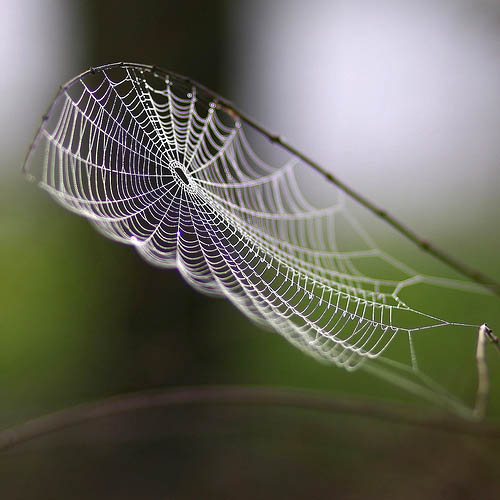 (image credit: Robert S. Donovan) Once the web is complete the spider bites off the three spirals at the center. Then it sits and it waits! Hopefully, before long, something plump and juicy will get stuck. The web is an incredibly efficient way of gathering food. The spider doesn’t have to go chasing after its prey – it simply waits. However, everything has its downside. The web is high in protein and as such its production takes a lot of energy. What a lot of spiders do is at the end of a day, when the web has lost a lot of its stickiness, they will eat it! In this way the spider recycles its own web and regains some of the energy it used to make the web in the first place. Dartboard 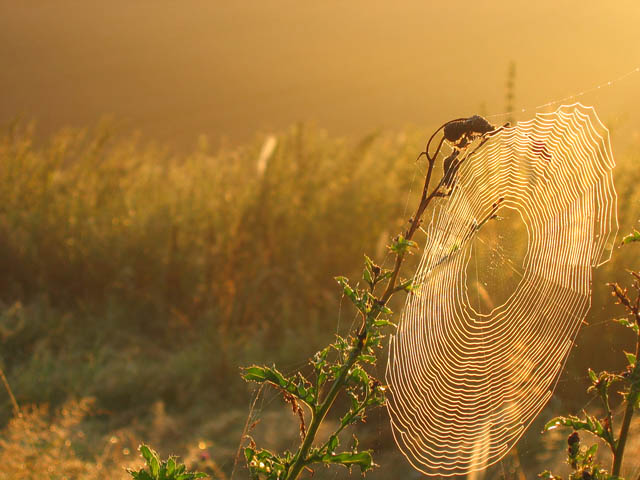 (image credit: Peter Olin) Spider silk has a greater tensile strength than a chunk of steel weighing the same amount. As scientists look more towards nature for their inspiration, more potential applications in industry are developed - from parts of artificial prosthetics, to bullet proof vests. On the downside, some scientists are already genetically modifying other animals to produce the proteins that make the web. How far we are away from a Frankenstein scenario is anyone’s guess. A Fairy’s Necklace  (image credit: Edith)  (image credit: Tollen) One question comes to mind: why don’t spiders stick to their own webs? Well, it is true they do not usually get glued in their own cobweb... However, they have to be careful! The spider has to choose where it will wait for its prey and that is always spun with the non sticky stuff. However, when they leave their monitoring position they do have to be careful to only climb along the non sticky threads! Otherwise they will become a meal for any passing creature, hoisted on their own petard! Flower Web 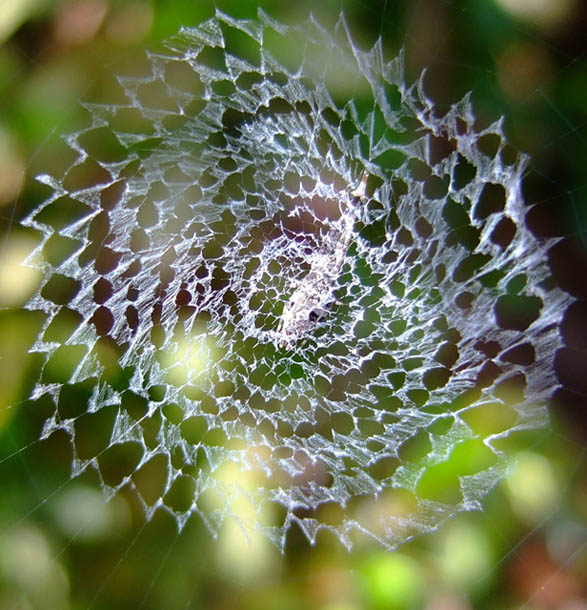 (image credit: James Baker) It should be pointed out here that some species of spider do not use webs at all, instead relying on more traditional methods of hunting, such as 'pouncing' or even openly chasing down their prey. However, without the spider web we would lose one of the more beautiful sights that Mother Nature has to offer... ... among other wonders in its marvelous glamour & jewelry shop: 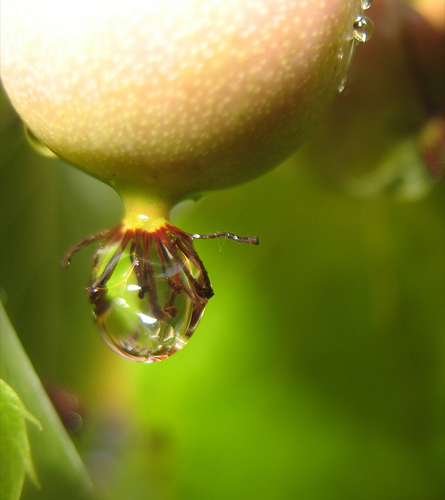 (image credit: Scott Stevens) Also read: Spiders! Close Up Photos Fungus, Lichen and Moss Permanent Link...  ...+Facebook ...+Facebook Category: Nature,Photography Dark Roasted Blend's Photography Gear Picks: |
Spider Webs Glamour & Architecture
Subscribe to:
Post Comments (Atom)
Check out this stream
Blog Archive
-
▼
2008
(968)
-
▼
August
(187)
- Link Latte 76
- Dancing Coloring Pages
- Funny Cowboy Coloring Pages
- Playing Piano Coloring Pages
- Book Worm Coloring Pages
- Cute Baby Coloring Pages
- Alien Coloring Pages
- Nice Family Coloring Pages
- Ornamental Coloring Pages
- Little Mermaid Coloring Pages
- Coloring Book
- Some of the World's Strangest Fences
- Aeroplane Coloring Pages
- Flowers Life Coloring Pages
- Dragon Coloring Pages
- Little Doggie Playing..
- Custard Kitty Coloring Pages
- Cool Cat Player Coloring Pages
- White dongle
- Bratz Doll Coloring Pages
- Transparent Underground
- Harmony Coloring Pages
- Coloring the World!
- Tinkerbell and Flower!
- Hibiscus Flower Coloring Pages
- Butterfly and Flower Coloring Pages
- Flower Coloring Pages
- 3 Flowers Bloom
- Bouquet of Roses
- Little Flower Coloring Pages
- Monowheels: The Weirdest Transport Known to Man
- Accidents Big and Small
- Robots: Art & Technology
- Fairy Coloring Pages; Resting
- Flower Fairy Coloring Pages
- In the Jungle
- Teenage fairy coloring pages
- Moon Fairy Coloring pages
- Silly Fairy Coloring Pages
- Fairy Coloring Pages
- Space Opera, Mexican Style
- Tinkerbell's Glimpse
- Tinkerbell Clapsing Hands
- A Big Gigle From Tinkerbell
- Preening Tinkerbell
- Resting Tinkerbell
- Angry Tinkerbell
- Jealous Tinkebell
- Hiding Tinkerbell
- Tinkerbell in the Ship
- Gigantic City-Structures of Paolo Soleri
- Link Latte 75
- Never Give Up! - Funny Pics, Part 9
- House Coloring Pages...
- Tiny Fairy Coloring Pages
- Smiling Fairy Coloring Pages
- Funny Fat Fairy
- Printable Fairy Coloring Pages
- Funny Tiger Coloring Pages
- Horse Coloring Pages
- Lamb Coloring Pages
- Family Guy Coloring Pages
- Grilling Coloring Pages
- Master Yoda Coloring Pages
- Drunk Animals in Africa
- Psychedelic Furniture, Part 2
- Funny Koala Coloring Pages
- Funny Bunny Coloring Pages
- Bird in spring season
- Cute Tiger Coloring Pages
- Cute Coloring Pages
- Lighthouses vs. Huge Waves
- Spider Webs Glamour & Architecture
- Butterfly Playing Ground
- Fat Butterfly Coloring Pages
- Butterflies in the sky
- Large Wing Butterfly Coloring Pages
- Butterfly Coloring Pages 2
- Butterfly Coloring Pages
- Link Latte 74
- Garfield Coloring Pages: Beach..
- Garfield Coloring Pages: Sleeping Time...
- Garfield Coloring Pages: Fall in Love
- Garfield Coloring Pages: Lunch!
- Garfield Coloring Pages
- Aladin Coloring Pages
- Cartoon Turtle Coloring Pages
- Learn to draw Dragon
- Tinkerbell Color Flower
- Care Bear Coloring Pages
- Sylvester tricky fire!
- Crazy Wiring, Part 5
- Love. Song. Italy...
- Sailormoon and Friends
- Naruto Coloring Pages
- Sailormoon Coloring Pages
- Cockatoo Coloring Pages
- New Bird Born Coloring Pages
- Yeehaa Coloring Pages
- Dora Coloring Pages: Swiper! No Swiping!
-
▼
August
(187)









0 comments:
Post a Comment